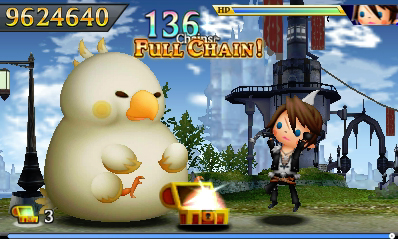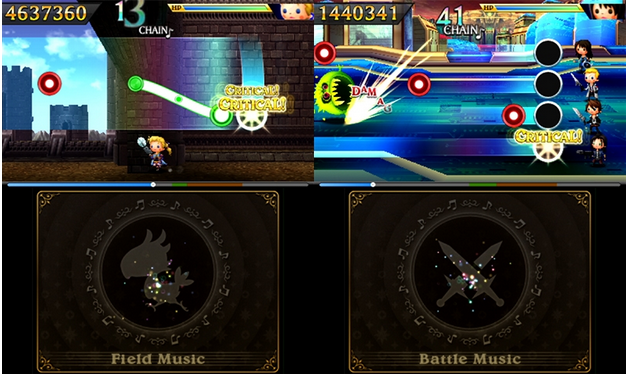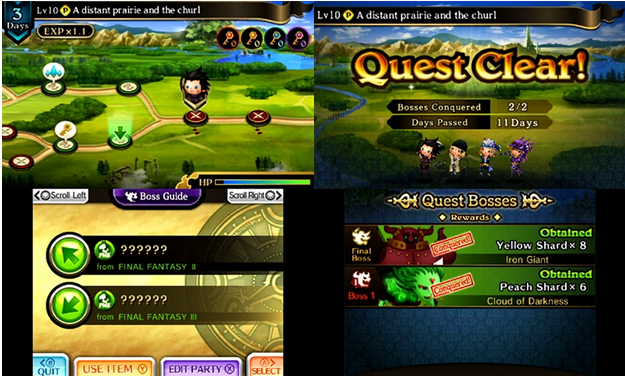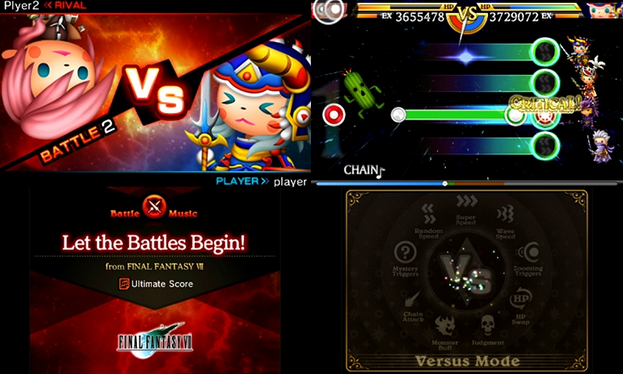TFF Review
Review: Theatrhythm Final Fantasy: Curtain Call
An endearing encore to 2012’s daring endeavor
Published on 09.12.2014 by Cesar M. CainelliJust two years ago, Square Enix introduced a fresh way to enjoy the Final Fantasy musical catalogue, uniting the ever-popular rhythm game with the immensely renowned themes from our favorite roleplaying games. THEATRHYTHM: FINAL FANTASY brought forth an addictive way to experience musical scores, but admittedly left players asking for more. Now, we have more. CURTAIN CALL is certainly not perfect… but with 221 songs out of the box, 60 characters to play, and revitalized game modes, it may as well be.

Fat Chocobo is excited for your victory!
THEATRHYTHM FINAL FANTASY: CURTAIN CALL is not some simple expansion pack. The game is rich with new features, and scores more forgivingly than its predecessor. New control styles are introduced; alongside stylus only, there are options for stylus with Circle Pad or buttons, and Circle Pad with face buttons. This time, all difficulty levels are available from the start; even for a veteran as myself, I was unable to immediately dive back into Ultimate difficulty given the length of time since playing the original title.
At the start of a new profile, the player is asked to form a party out of a broad spectrum of characters. It is wise to choose a variety, as the music available to play is initially based upon your party members. Series veterans will recognize the need for a speedy lead for Field Music Stages [FMS], where you travel through overworlds, towns, dungeons, and even airships, all featuring familiar themes; strong physical or magical attackers for the enemy-laden Battle Music Stages [BMS], where your party of four lines up and attacks notes as they approach; and a healer or hybrid character to round out the party, especially as beginners may need some HP recovery. Event Music Stages [EMS] are also showcased via unlocks through conditional requirements or Rhythmia gain. Rhythmia is the lifeblood of Theatrhythm, and is the driving factor to unlock new content.

Sample Field and Battle Music Stages.
Upon selecting four heroes, the game launches a brief interactive tutorial, covering everything necessary for a basic understanding of the game. After playing just six songs from the Music Stages free play mode, Quest Medley mode is unlocked. Through more gameplay and Rhythmia gain, Versus Mode, Streetpass Mode, the Museum, and more will become available. The roleplaying aspect of the game is immediately visible as well; all characters will level up and learn new abilities which can assist in speedy travel, powerful attacks, party-boosting medleys, and much more.
A refreshing take on the prior entry’s Chaos Shrine mode, the new Quest Medley Mode provides short, medium, and long maps full of melodic madness. The major difference in map length is the number of boss fights; each boss fight provides a fixed number of colored crystal shards which are required to unlock new characters. Maps often have multiple paths, and completing a map randomly generates a new map for you based upon the level of your current party. Within Quest Medley Mode, there is a fourth option - inherited maps. These are the maps you collect from other players via the 3DS Streetpass functionality.

Zack leads his party to great success, obtaining enough shards to unlock new characters!
Replacing the previous entry’s cooperative play is a challenging Versus Mode. In this mode, players may take on the AI challenge ladder or square off against friends via local or online play. Players meet head to head in BMS competition, building combo chains and landing critical notes to randomly select an impairment to impose upon the opponent. Impairments range from Random Speed (shown below), where each line moves at a different pace, to Judgment, where the scoring for a critical hit is much tougher, and everything that is not a critical is scored as a bad and reduces your points instead. Mog will also announce when you successfully attack the other party - and when they successfully attack you - though this option may be muted prior to entering battle, kupo!
Collectacards make a return this time as well, but serve a greater purpose than simply filling out a catalogue in the Museum. In this entry, players can utilize these Collectacards - trading cards featuring information on characters and enemies - to permanently boost the statistics of the playable characters. Collectacards can be combined up to eight at a time in Shin Megami Tensei fashion, with compatible cards harboring greater chances for success rate and larger bonuses to select statistics.

Warrior of Light needs to step up his game and put Lightning’s party to rest!
Square Enix and indieszero have taken the addictive qualities of the first Theatrhythm title and amplified them in the best possible ways. CURTAIN CALL provides limitless replayability to fans of games like Rock Band and Guitar Hero, offering a unique melodic experience for your fingertips. Fans of the iconic music of the Final Fantasy franchise are certain to fall in love with this second entry in the Theatrhythm library.
THEATRHYTHM FINAL FANTASY: CURTAIN CALL receives
5 out of 5 crystal shards.
FULL DISCLOSURE: Square Enix provided an advance copy of TFF:CC for the purpose of this review.
THEATRHYTHM FINAL FANTASY: CURTAIN CALL will be available 16 September 2014 in North America, and 19 September 2014 in Europe.
To discuss this article and offer your own thoughts, visit the article commentary.
Be sure to check out our complete list of other Final Fantasy Reviews.